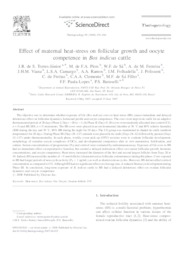Effect of maternal heat-stress on follicular growth and oocyte competence in Bos indicus cattle.
Effect of maternal heat-stress on follicular growth and oocyte competence in Bos indicus cattle.
Author(s): TORRES-JÚNIOR, J. R. S.; PIRES, M. F. A.; SÁ, W. F.; FERREIRA, A. de M.; VIANA, J. H. M.; CAMARGO, L. S. A.; RAMOS, A. A.; FOLHADELLA, I. M.; POLISSENI, J.; FREITAS, C.; CLEMENTE, C. A. A.; SÁ FILHO, M. F.; PAULA-LOPES, F. F.; BARUSELLI, P. S.
Summary: The objective was to determine whether exposure of Gir (Bos indicus) cows to heat-stress (HS) causes immediate and delayed deleterious effect on follicular dynamics, hormonal profile and oocyte competence. The cows were kept in tie-stalls for an adaptive thermoneutral period of 28 days (Phase I, Days ?28 to ?1). In Phase II (Days 0–28) cows were randomly allocated into control (CG, n = 5) and HS (HS, n = 5) treatments. The HS cows were placed in an environmental chamber at 38 °C and 80% relative humidity (RH) during the day and 30 °C, 80% RH during the night for 28 days. The CG group was maintained in shaded tie-stalls (ambient temperature) for 28 days. During Phase III (Days 28–147) animals were placed in tie-stalls (Days 28–42) followed by pasture (Days 42–147) under thermoneutrality. In each phase, weekly ovum pick up (OPU) sessions were to evaluate follicular development, morphology of cumulus–oocyte complexes (COCs), and developmental competence after in vitro maturation, fertilization, and culture. Serum concentrations of progesterone (P4) and cortisol were evaluated by radioimmunoassay. Exposure of Gir cows to HS had no immediate effect on reproductive function, but exerted a delayed deleterious effect on ovarian follicular growth, hormone concentrations, and oocyte competence. Heat-stress increased the diameter of the first and second largest follicles from Days 28 to 49. Indeed, HS increased the number of >9 mm follicles (characterized as follicular codominance) during this phase. Cows exposed to HS had longer periods of non-cyclic activity (P4 < 1 ng/mL), as well as shorter estrous cycles. However, HS did not affect cortisol concentration as compared to CG. Although HS had no significant effect on cleavage rate, it reduced blastocyst development during Phase III. In conclusion, long-term exposure of B. indicus cattle to HS had a delayed deleterious effect on ovarian follicular dynamics and oocyte competence.
Publication year: 2008
Types of publication: Journal article
Unit: Embrapa Dairy Cattle
Keywords: Bos Indicus, Gir, Heat-stress, IVF, Oocyte, Ovarian follicle, PIV, animal reproduction
Observation
Some of Embrapa's publications are published as ePub files. To read them, use or download one of the following free software options to your computer or mobile device. Android: Google Play Books; IOS: iBooks; Windows and Linux: Calibre.
Access other publications
Access the Agricultural Research Database (BDPA) to consult Embrapa's full library collection and records.
Visit Embrapa Bookstore to purchase books and other publications sold by Embrapa.

